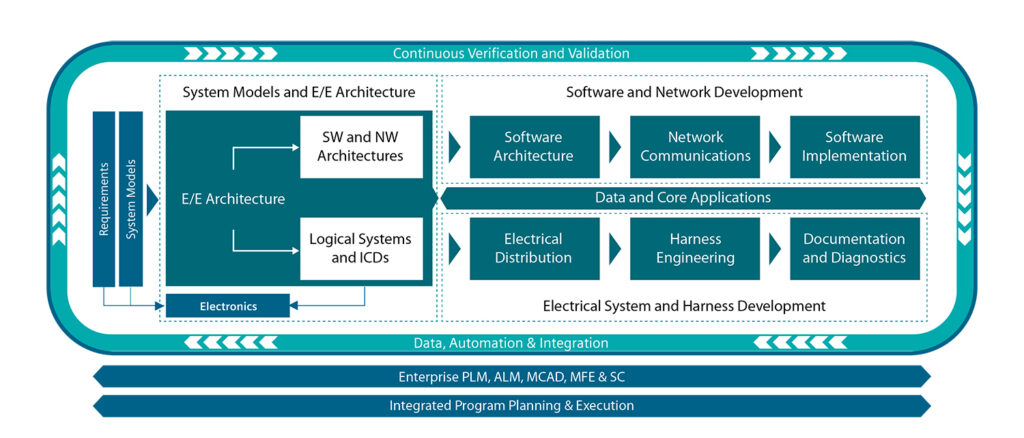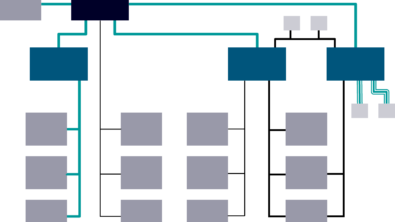How to remove barriers in E/E systems development

Widespread electrification and growing product intelligence are causing a significant increase in the importance and complexity of the electrical and electronic (E/E) systems within a variety of products, from passenger cars and aircraft to marine vessels and advanced industrial machinery. The rapid growth in complexity, in fact, has outpaced predictions. In 2014, Deutsche Bank conducted a study in which they measured rising vehicle complexity based on the software lines of code (SLOC) and the number of network signals implemented within a typical vehicle at various times. The study predicted that the average vehicle in 2020 would contain 30 million SLOC and 10,000 network signals, both of which were at least double what was reported for a vehicle from 2012. According to conversations with our customers, the vehicles in 2020 can have 150 million SLOC and more than 20,000 network signals, and this growth is only expected to continue.
Industries face a multi-domain challenge
Growing E/E system complexity, however, is not just a matter of an increase in the amount of electrical, electronic or software contents of a product. Each sub-system must incorporate a diverse combination of domains to enable product functionality. Take, for example, an automated take-off and landing system in a commercial aircraft. This system uses a combination of electrical wiring, electronic devices, embedded software, hydraulic and mechanical systems to guide the plane down the runway, control the throttle, engage or retract landing gear and operate control surfaces to ensure safe take-off and landing.
This cross-domain complexity also heightens the challenge of maintaining traceability throughout the product development lifecycle. Engineers now have to track thousands of components and functions across domains, coordinating the development, simulation and validation of electrical systems, electronic control units (ECUs), software applications and more.
Traditionally, companies have taken a siloed approach to developing vehicle systems, with teams located in different offices, sites or countries. These silos can result in an inconsistent application of requirements in sub-system designs, lack of communication between domains and missing links in design traceability. These misinterpretations only become evident when different contributing aspects of systems are integrated together. For example, electrical, network, software and hardware teams may make different assumptions about network message timing and/or the signals passed between ECUs. The discovery of such inconsistencies necessitates additional engineering effort to resolve the issues that arise from incompatible systems. The result is increased cost, missed deadlines and greater program risk.
Manufacturers of aircraft, passenger cars, off-highway vehicles and industrial machinery seek to turn the growing complexity of E/E systems into a competitive advantage through innovative designs. To do so, these companies must evolve their E/E system development methodologies to meet the challenges of the markets of tomorrow. The next generation of development methodologies must blur the boundaries between software, electrical, electronic and network development to ensure holistic traceability and accelerate product development. These methodologies must also leverage automation to enable faster, more frequent design analysis and iteration and to allow engineers to focus on product innovation instead of repetitive design tasks.
Next level E/E systems development with an end-to-end environment
The need for today and the future is to support integrations across domains, blurring the boundaries between silos to provide persistent data continuity throughout E/E systems design, manufacturing and service (figure 1). With this approach, companies drive electrical, electronics, network and embedded software architecture design from the E/E systems architecture. Downstream support for harness manufacturing and vehicle service domains completes a comprehensive E/E systems development environment.

These comprehensive E/E systems development capabilities provide a number of benefits to companies developing next generation products. Key benefits include faster time-to-market, reduced program risk, improved product quality, streamlined collaboration and a focus on innovation.
An integrated, end-to-end E/E systems development environment will support companies as they strive to overcome complexity and reduce time to market. Capital, from Siemens Digital Industries Software, features unparalleled reach to drive electrical distribution system, networks and embedded software design, as well as the creation of manufacturing and product service deliverables from the E/E architecture. As a part of the Siemens Xcelerator portfolio, tight integration with mechanical, PLM, simulation and manufacturing planning solutions ensure that E/E systems designs support model-based systems engineering, contributing to a comprehensive digital twin of the product and production methods.
As companies embark on their digital transformations the Siemens Xcelerator portfolio will help realize the critical characteristics of a digital enterprise: the comprehensive digital twin, personalized solutions and participation in an open industrial ecosystem. To learn more, please read our whitepaper Blurring boundaries in E/E systems development.
You might also be interested in:


